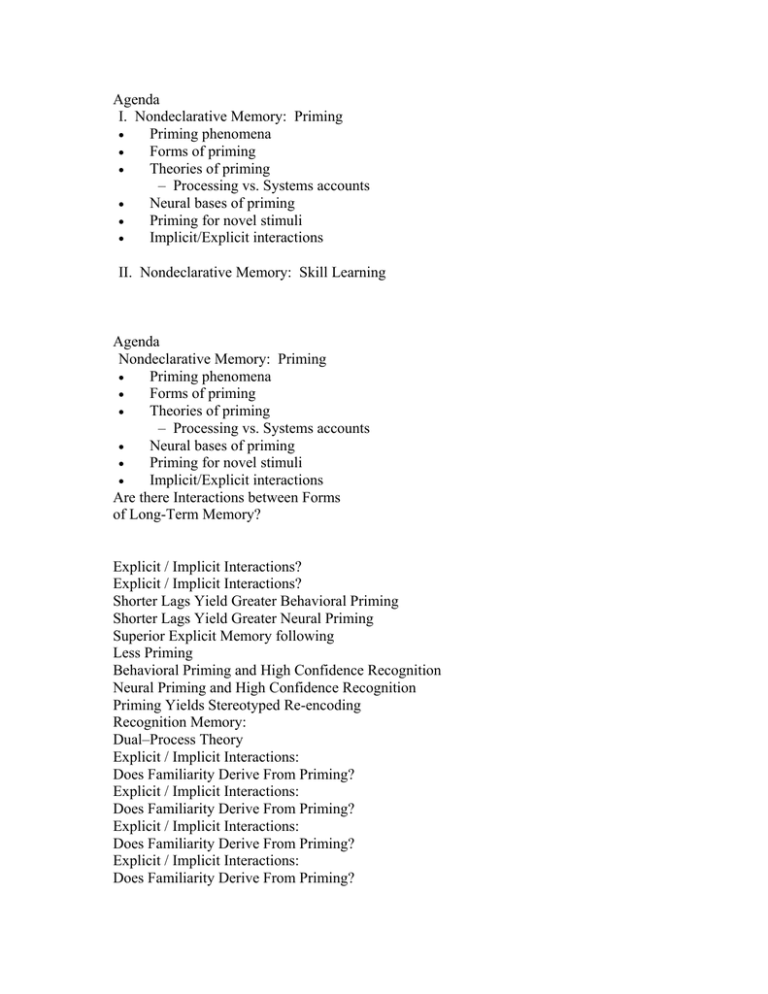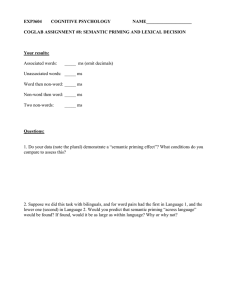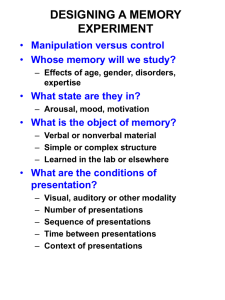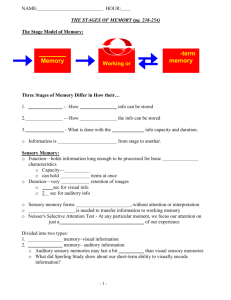Agenda I. Nondeclarative Memory: Priming Priming phenomena Forms of priming
advertisement

Agenda I. Nondeclarative Memory: Priming • Priming phenomena • Forms of priming • Theories of priming – Processing vs. Systems accounts • Neural bases of priming • Priming for novel stimuli • Implicit/Explicit interactions II. Nondeclarative Memory: Skill Learning Agenda Nondeclarative Memory: Priming • Priming phenomena • Forms of priming • Theories of priming – Processing vs. Systems accounts • Neural bases of priming • Priming for novel stimuli • Implicit/Explicit interactions Are there Interactions between Forms of Long-Term Memory? Explicit / Implicit Interactions? Explicit / Implicit Interactions? Shorter Lags Yield Greater Behavioral Priming Shorter Lags Yield Greater Neural Priming Superior Explicit Memory following Less Priming Behavioral Priming and High Confidence Recognition Neural Priming and High Confidence Recognition Priming Yields Stereotyped Re-encoding Recognition Memory: Dual–Process Theory Explicit / Implicit Interactions: Does Familiarity Derive From Priming? Explicit / Implicit Interactions: Does Familiarity Derive From Priming? Explicit / Implicit Interactions: Does Familiarity Derive From Priming? Explicit / Implicit Interactions: Does Familiarity Derive From Priming? Explicit / Implicit Interactions: Does Familiarity Derive From Priming? Explicit / Implicit Interactions: Does Familiarity Derive From Priming? Explicit / Implicit Interactions: Does Familiarity Derive From Priming? Explicit / Implicit Interactions: Does Familiarity Derive From Priming? Explicit / Implicit Interactions: Does Familiarity Derive From Priming? Agenda Non-declarative Memory: Skill Learning • Characteristics of skill learning • Theories of skill learning – ACT-* – Instance theory • Varieties of skill learning – Motor skill – Perceptual skill – Cognitive skill Acquisition of new behavioral abilities with practice Contrast with repetition priming: – Repetition priming is defined as facilitation on a particular stimulus – Skill learning is defined as facilitation on a range of stimuli in a particular task 1) Cognitive stage – Initial (often verbal) characterization of skill used to guide behavior – Requires working memory capacity 2) Associative stage – Behavior becomes tuned, errors are eliminated – Verbal mediation drops out 3) Autonomous stage – Gradual continued improvement of skill – Little reliance upon working memory Skill learning: associated with automatic (as opposed to controlled) processing – Less attention-demanding – Reduced interference with other ongoing processes or tasks – Reduced need for conscious control However, automaticity does not imply that behavior is uncontrollable – Many examples of skill (driving, reading, typing) are highly controllable, in that they can be stopped at any time Decrease in response times with skill learning on a wide range of tasks can be described by a power function: RT = A + BN -β A=asymptote B=start–asymptote -β =learning rate Production system model of memory – If-then rules triggered by contents of working memory Learning involves transition from declarative to procedural memory Declarative stage: – Existing productions are chained together – Relevant information is held in working memory Procedural stage: – Multiple productions are chained into single productions with declarative knowledge built in → decreases working memory requirements – New compiled productions are strengthened Goal: Type the word “hot” Variables: L1=h, L2=o, L3=t Productions: – If the goal is to type a word & the 1st letter of the word is L1, • Then type L1 – If the goal is to type a word & the 2nd letter of the word is L2, • Then type L2 – If the goal is to type a word & the 3rd letter of the word is L3, • Then type L3 After practice, composition and proceduralization lead to the following production: – If the goal is to type “hot”, type “h”, “o”, and “t” Strengths: – Makes detailed behavioral predictions – Predicts power function speedup Weaknesses: – Has primarily been applied to verbal cognitive tasks – Not clear that declarative-to-procedural transition is a valid descriptor of all types of skill acquisition Instance/exemplar-based memory – Each episode results in a memory trace containing the contents of attention – Each instance retrieves all similar traces from memory Race between memory and algorithm – Performance initially driven by algorithm (or analogy) – Memory retrieval time decreases as power function of number of instances stored in memory • Memory retrieval soon comes to dominate performance • Even when average memory retrieval time is longer than algorithm time Strengths: – Predicts changing shape of response time distributions with learning Weaknesses: – Current incarnation only models response times – Does not make behavioral predictions Skill learning is tested in a number of domains – Motor skill – Perceptual skill – Cognitive skill Novel perceptual-motor mappings – Mirror-tracing – Prism adaptation Novel movement patterns / sequences – Rotary pursuit – Motor sequence learning Motor skill learning is usually intact in amnesia – Rotary pursuit – Mirror-tracing – Motor sequence learning But motor skill learning is sometimes impaired in amnesia – Maze learning – Higher-order motor sequence learning – Exceptions may require higher-order relational or spatial learning Other forms are spared: – Mirror-tracing BG may play particular role in open-loop motor skills Imaging shows increasing putamen activity with motor skill acquisition Neuropsychology: – cerebellar lesions sometimes impair motor learning – pattern tracing (Sanes, Dimitrov, & Hallett, 1990) Imaging: – decreased cerebellar activation with acquisition of very simple motor tasks – cerebellar activation related to errors on motor tasks Neurophysiology: – Increased # of synapses in cerebellar cortex accompanies motor skill learning in rats (Greenough et al.) Neuropsychology: – Little evidence about role of cortex in memory for motor skills – SMA lesions impair SRT and tracking – Evaluation of role of motor cortex is difficult • Motor control impairments following cortical lesions • Cortical lesions are often large Neuroanatomy: – Size of motor cortex is correlated with long-term motor skill acquisition (Amunts et al., 1997) Neurophysiology: – changes in cortical maps with skill learning – areal expansion for trained movements Novel perceptual recognition skills – Mirror-reading – Low-level visual discrimination (e.g., vernier discrimination) – Object discrimination (e.g., Greebles) Intact mirror-reading in amnesia Neuropsychology: – HD patients mildly impaired at mirror-reading skill – PD patients are variably impaired • Some studies find severe impairment • Others find no impairment Neuroimaging: – Imaging shows learning-related changes in caudate Frontal, occipital, and cerebellar lesions do not impair mirror-reading Categorization learning – Probabilistic classification • Weather prediction task Strategic game learning – Tower of Hanoi • Learned using recursive subgoaling strategy Tower of Hanoi – Amnesic patients are sometimes normal – Other studies have found impaired learning Probabilistic Classification – Amnesics show normal early learning – Seem to show impaired later learning Tower of Hanoi – Learning intact following cerebellar lesions – Learning impaired in HD and PD – Learning impaired following frontal lesions Probabilistic classification learning – Learning impaired in PD and HD – Imaging shows activation of caudate nucleus which decreases with learning – Learning intact following frontal lesions Skill learning is (mostly) independent of MTL Basal ganglia are involved in a wide range of skills Different cortical regions important depending upon nature of skill Cerebellum important for motor skills Two ways that the brain changes during skill learning – Tuning of existing processes/representations • Existing representations are dynamically altered – Switching to new processes/representations • • Task is performed in a completely different manner May reflect race/competition between multiple processes



